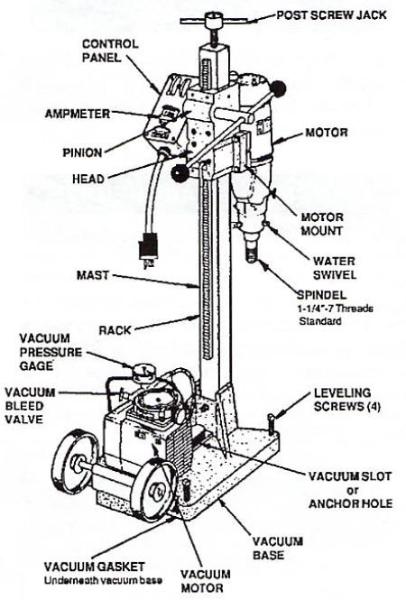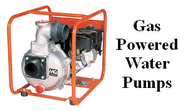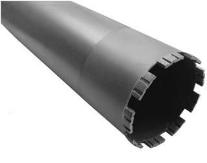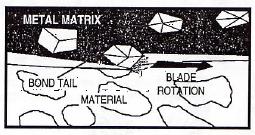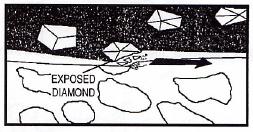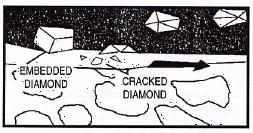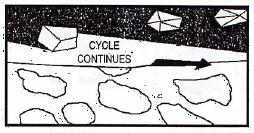Glazed / Polished Bits - Causes & Remedies
|
|
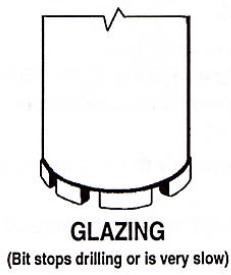 |
|
Possible Cause: Too much feed pressure
Remedy: Open the bit with an abrasive material (Such as sand pot,
concrete block, cinder block, etc.)
Possible Cause: Aggregate is too hard. (Example using a bit designed for
soft abrasive material to drill concrete).
Remedy: Use a core drill bit designed with a softer bond.
Possible Cause: RPM of core drill is too high for the bit diameter. Surface
speed of the bit rotation is a function of RPM and diameter. A fast rotation
speed is necessary for small bits, but as bits get larger - circumfrence speed
increases relative to π. Too fast and the bit will glaze.
Remedy: Adjust motor speed (if possible), otherwise you will need to
purchase a motor with an appropriate speed.
|
|
 |
Bent Bits - Causes & Remedies
|
|
|
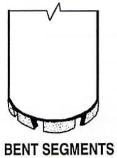 |
|
Possible Cause: Too much feed pressure & Not enough water
Remedy: Repair the bit (if possible). Ease up on the feed pressure and increase water
flow.
Possible Cause: Aggregate is too hard. (Example using a bit designed for soft abrasive
material to drill concrete).
Remedy: Use a core drill bit designed with a softer bond.
|
|
|
|
 |
Lost Segments - Causes & Remedies
|
|
|
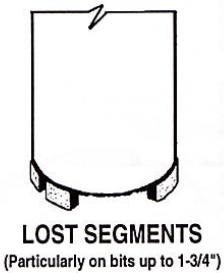 |
|
|
|
Possible Cause: Steel reinforcing rod
Remedy: Ease up on the feed pressure. Use a higher quality bit and
increase the water flow.
Possible Cause: Not enough water to properly cool bit.
Remedy: Increase water flow.
Possible Cause: Drill rig is not properly anchored.
Remedy: There are three ways of anchoring a core rig. STANDING ON IT IS
NOT ONE OF THEM! This quick and dirty method damages the bit and the
rig as well as dramatically slowing the drilling process.
|
|
|
|
|
 |
Hung / Stuck Bits - Causes & Remedies
|
|
|
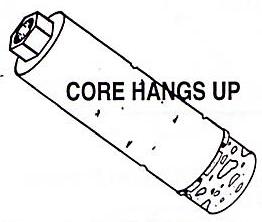 |
|
Possible Cause: Not enough water to remove slurry.
Remedy: Remove bit and drive core out with a spike through the hub.
Increase water flow.
Possible Cause: Core barrel is dented because of hammering on it
to remove previous hung up cores.
Remedy: Repair the barrel (if possible). Increase water flow.
|
|
|
|
 |
How to Remove a STUCK Bit - Without Damaging it.
|
|
|
STEP 1: Disconnect
the core rig from the bit.
|
|
STEP 3: Place two
hex nuts on the rod and
lock them against one
another so that they in
turn lock themselves on
the rod.
|
|
STEP 4: Turn the
nuts with a wrench which
will turn the rod which will
push against the
concrete core, pulling
the bit from the hole
without damaging it.
|
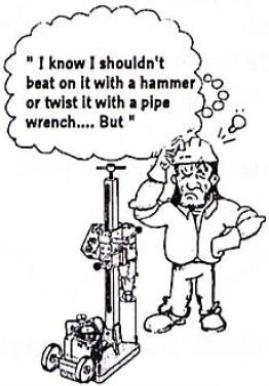 |
|
|
|
|
|
|
STEP 2: Thread a
piece of threaded rod
the same diameter as
the bit (Bit sizes 1.5" and
smaller use 5/8-11
thread and larger bits
use 1-1/4-7 thread).
Thread through the hub
until it hits concrete.
|
|
|
|
|
|
|
|
|
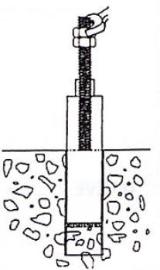 |
|
|
|
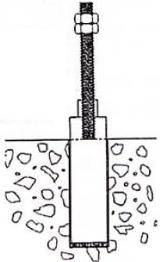 |
|
|
|
|
|
|
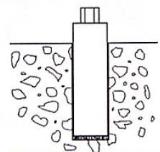 |
|
|
|
|
|
|
|
|
|
|
|
|
